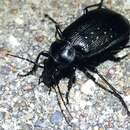Comprehensive Description
(
Inglês
)
fornecido por Smithsonian Contributions to Zoology
Calosoma sayi Dejean
Calosoma sayi Dejean, 1826:198. [Lectotype female, “Amérique septenlrionale” {Say) (MNHP), herein selected.]
Calosoma armata LaPorte, 1835:156. [Lectotype male, MEXICO (Gory) (MNHP), herein selected.]
Calosoma sayi abdominale Géhin, 1885:58. [Lectotype male, MEXICO (MNHP), herein selected.]
Calosoma sayi virginica Casey, 1897:344. [Lectotype male, USA, Virginia, Norfolk (Casey) (USNM), herein selected.]
Calosoma cuprascens Roeschke, 1900:71. [Holotype male, probably Greater Antilles (depository unknown).]
DIAGNOSTIC COMBINATION.—These beetles are very similar to the preceding species except the elytral costae are more or less equally wide and only moderately raised. The males have two basal tarsal articles of the anterior leg clothed beneath with spongy pubescence. Color and luster: blackish with cupreous or greenish reflections; blackish to green on head and pronotum, mouthparts, appendages, and venter dark piceous. Form: size medium, narrow, females not wider than males; eyes large and prominent Structure: elytral intervals moderately convex, 3, 7, and 11 catenate with large, deep foveae, all transversely scaly; head rugosely punctate. Microsculpture finely isodiametric or on pronotum slightly transverse. Male with 2 dilated basal tarsal articles on foreleg, each with setiferous pad beneath; middle tibia with large brush of setae apicomedially; metatrochanter ventrally hooked apically; and male median lobe moderately bent laterally near apex. Female without tarsal pads, trochanter hooks; with multiple setae on sternum VI. ABL = 22.0 mm to 30.0 mm; TW = 9.0 to 12.0 mm (from Gidaspow, 1959).
GEOGRAPHICAL DISTRIBUTION (Figure 21).—The range of this species extends from the northeastern United States south to Panama and throughout the Greater Antilles.
NATURAL HISTORY.—In Central America, these beetles are found in TROPICAL DRY and VERY DRY FORESTS, TROPICAL MOIST FOREST, PREMONTANE MOIST, and WET FORESTS in cultivated lands, along streams and rivers, and in scrub lands, from sea level to 1210 m. All specimens studied are fully winged; the species is a highly vagile dispersant. They may be found in January, February, April, May, June, July, and August.
TAXONOMY.—Gidaspow (1963) discusses at length the taxonomic problems involved with this species and its sister species, C. alternans. I discuss the problem under that species (see above). I do not believe that subspecies are warranted given the present level of study on the material at hand; thus I regard C. abdominale Géhin and C. virginica Casey as junior synonyms of C. sayi. It appears to me all these are based on a few specimens from different places and that no one has had good enough series to show separately evolving populations. Until this kind of study is done, I prefer to regard the species as monotypic, treating all the various proposed names as synonyms.
MATERIAL EXAMINED.—Types (see above) and 47 specimens (Table 4).
- citação bibliográfica
- Erwin, Terry L. 1991. "The ground beetles of Central America (Carabidae) I: Carabinae (in part): Notiophilini, Loricerini, Carabini." Smithsonian Contributions to Zoology. 1-30. https://doi.org/10.5479/si.00810282.501

